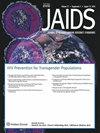艾滋病病毒感染者的睡眠、睡眠呼吸暂停和疲劳。
IF 2.9
3区 医学
Q3 IMMUNOLOGY
JAIDS Journal of Acquired Immune Deficiency Syndromes
Pub Date : 2024-10-01
DOI:10.1097/qai.0000000000003481
引用次数: 0
摘要
背景艾滋病病毒感染者(PLWH)即使在病毒载量得到抑制的情况下也经常报告疲劳。阻塞性睡眠呼吸暂停(OSA)通常与疲劳有关,在艾滋病病毒感染者中很常见,但 OSA 是否能解释这一人群的疲劳问题尚不清楚。患有和未患有 OSA 的患者在慢性疾病治疗功能评估得分上没有差异,但使用 Epworth 嗜睡量表测量,患有 OSA 的患者白天嗜睡程度更高。在一个多变量模型中,疲劳的预测因素包括每日睡眠时间更长和平均活动次数减少。结论 在我们的 PLWH 群体中,OSA 非常常见,OSA 患者嗜睡程度更高,但疲劳程度并不更高。睡眠时间的不稳定性与疲劳的增加有关。需要进一步研究以确定治疗 OSA 或强调睡眠的连贯性和时间安排是否能改善 PLWH 的疲劳症状。本文章由计算机程序翻译,如有差异,请以英文原文为准。
Sleep, Sleep Apnea, and Fatigue in People Living With HIV.
BACKGROUND
People living with HIV (PLWH) often report fatigue even when viral load is suppressed. Obstructive sleep apnea (OSA), which is often associated with fatigue, is common in PLWH, but whether OSA explains fatigue in this population is unknown.
SETTING
Academic university-affiliated HIV and Sleep Medicine Clinics.
METHODS
PLWH, aged 18-65 years, with a body mass index of 20-35 kg/m2 and viral suppression (RNA <200 copies per mL), were recruited to undergo daytime questionnaires, including the Functional Assessment of Chronic Illness Therapy Fatigue Scale and Epworth Sleepiness Scale, 7 days of actigraphy (to determine daily sleep duration and activity amplitude and rhythms), and an in-laboratory polysomnography to assess for the presence and severity of OSA.
RESULTS
Of 120 subjects with evaluable data, 90 (75%) had OSA using the American Academy of Sleep Medicine 3% desaturation or arousal criteria, with an apnea-hypopnea index >5/h. There was no difference in Functional Assessment of Chronic Illness Therapy scores between those with and without OSA, although those with OSA did report more daytime sleepiness as measured using the Epworth Sleepiness Scale. In a multivariable model, predictors of fatigue included more variable daily sleep durations and decreased mean activity counts. Sleepiness was predicted by the presence of OSA.
CONCLUSION
OSA was very common in our cohort of PLWH, with those with OSA reporting more sleepiness but not more fatigue. Variability in sleep duration was associated with increased fatigue. Further study is needed to determine if treatment of OSA, or an emphasis on sleep consistency and timing, improves symptoms of fatigue in PLWH.
求助全文
通过发布文献求助,成功后即可免费获取论文全文。
去求助
来源期刊
CiteScore
5.80
自引率
5.60%
发文量
490
审稿时长
3-6 weeks
期刊介绍:
JAIDS: Journal of Acquired Immune Deficiency Syndromes seeks to end the HIV epidemic by presenting important new science across all disciplines that advance our understanding of the biology, treatment and prevention of HIV infection worldwide.
JAIDS: Journal of Acquired Immune Deficiency Syndromes is the trusted, interdisciplinary resource for HIV- and AIDS-related information with a strong focus on basic and translational science, clinical science, and epidemiology and prevention. Co-edited by the foremost leaders in clinical virology, molecular biology, and epidemiology, JAIDS publishes vital information on the advances in diagnosis and treatment of HIV infections, as well as the latest research in the development of therapeutics and vaccine approaches. This ground-breaking journal brings together rigorously peer-reviewed articles, reviews of current research, results of clinical trials, and epidemiologic reports from around the world.

 求助内容:
求助内容: 应助结果提醒方式:
应助结果提醒方式:


